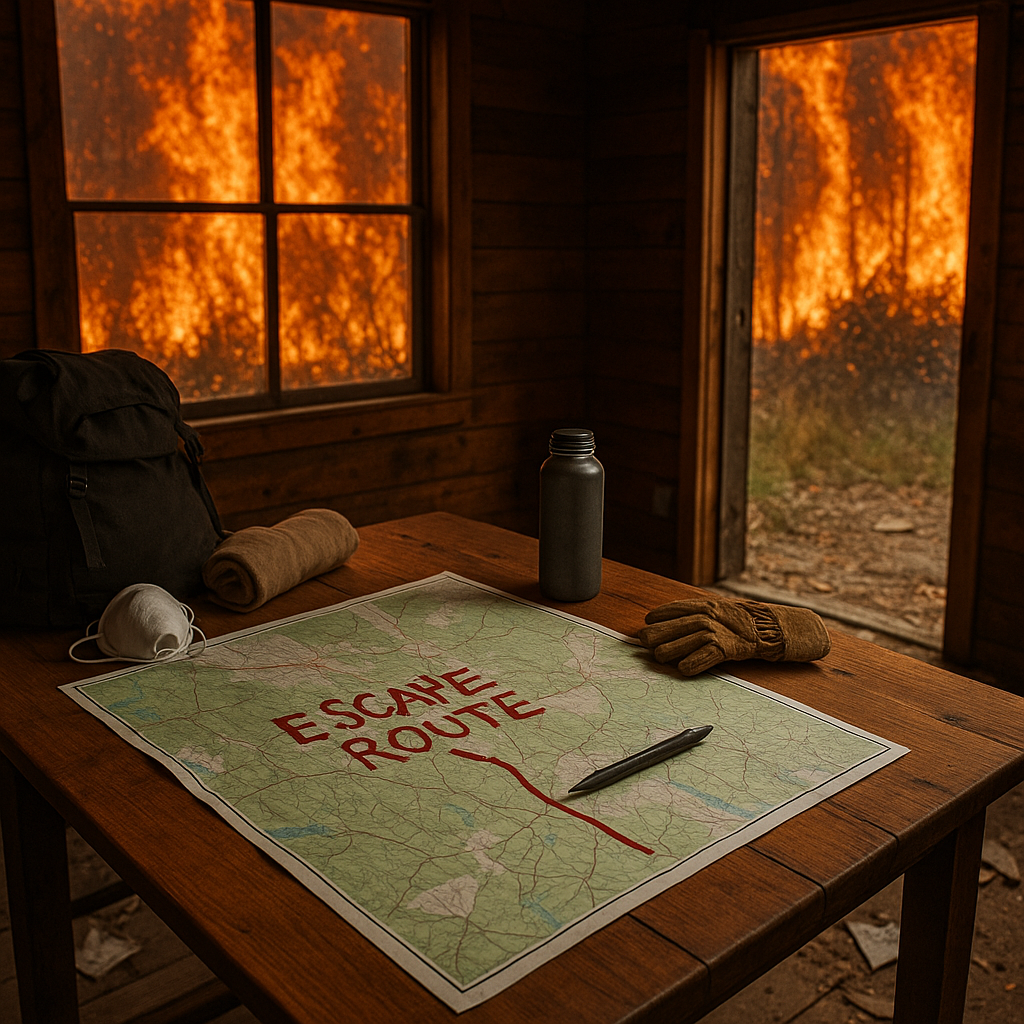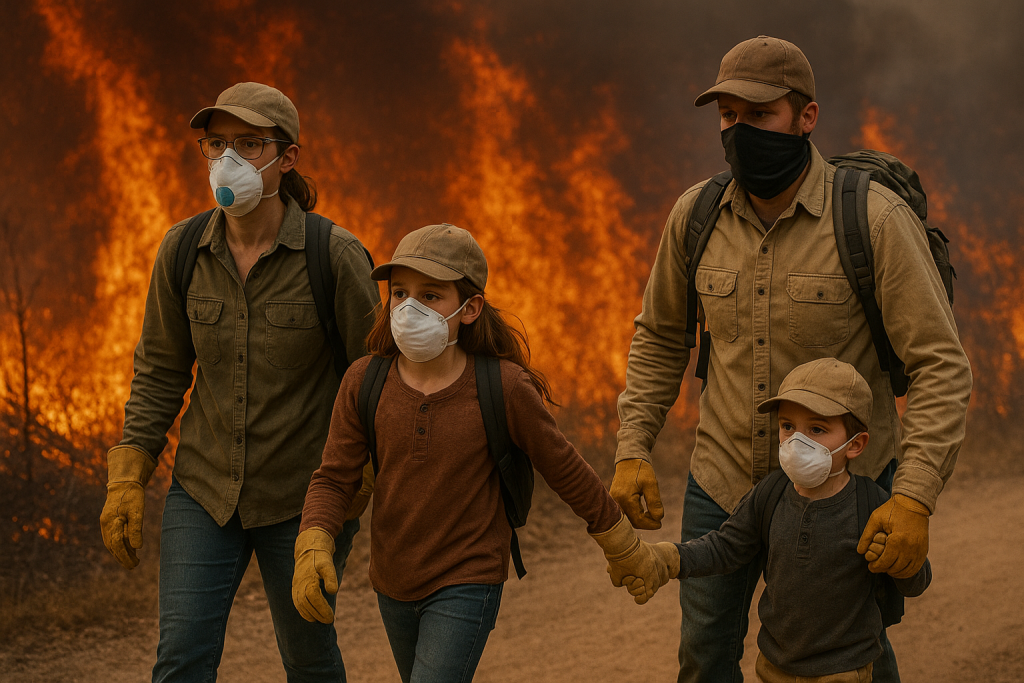Wildfires move fast. Flames can leap across roads, embers can fly for miles, and smoke can turn daylight into darkness in minutes. When the evacuation order comes, every second counts. But one overlooked detail can determine survival: the clothes on your back.
This guide will show you the best clothing for wildfires, what materials to avoid, and how to prepare an emergency evacuation kit with the right gear.

Why Clothing Matters in a Wildfire Evacuation
The Reality of Wildfire Dangers
When fleeing a wildfire, people often think about escape routes and emergency supplies. Clothing feels secondary—until it isn’t. The wrong outfit can increase burns, trip hazards, or even suffocation risks.
Heat, Embers, and Smoke Exposure
Clothing creates a barrier between your skin and the wildfire’s extreme environment. Thick fabrics protect against flying embers, while breathable materials prevent overheating. Smoke and falling ash can also burn exposed skin.
Injuries from Flying Debris and Hot Surfaces
During chaotic evacuations, debris like broken glass, twisted metal, and smoldering branches often litter the ground. Proper footwear and durable clothing can mean the difference between safe passage and serious injury.
Choosing the Best Clothing for Wildfires
Cotton and Wool: Natural Fire-Resistant Choices
Cotton and wool don’t melt like synthetics. Wool is especially effective—it resists flames, insulates even when wet, and provides a layer of protection from heat.
Modern Fire-Resistant Fabrics (FR Clothing)
Specialized fire-resistant (FR) clothing, often used in industrial settings, is a strong option for wildfire zones. Shirts, pants, and jackets made with Nomex or treated cotton reduce ignition risks.
What to Avoid: Synthetics That Melt
Nylon, polyester, and spandex can melt under heat, fusing into the skin and causing severe burns. Avoid lightweight synthetic athletic wear, no matter how comfortable it feels.
Why Footwear is Crucial for Survival
Sturdy Boots vs. Sandals and Flip-Flops
Sandals and flip-flops leave feet vulnerable to burns, cuts, and punctures. Sturdy leather boots or heavy-duty hiking shoes are far superior.
Steel-Toe or Reinforced Shoes for Protection
Steel-toe boots or reinforced shoes provide extra defense against falling objects and smoldering debris—especially critical if you must move through rubble.
Essential Protective Accessories
Gloves to Shield Your Hands
Work gloves protect against hot surfaces, sharp objects, and rough terrain. Keep a pair in your evacuation kit.
Goggles and Face Protection Against Smoke and Embers
Shatterproof goggles shield your eyes from blowing ash, sparks, and debris. Regular sunglasses aren’t enough.
Respiratory Masks and Bandanas
A simple N95 mask or even a damp cotton bandana can filter harmful particles and reduce smoke inhalation.
Hats and Head Coverings
Wide-brimmed hats or cotton caps add extra protection for your head, scalp, and ears—often overlooked but highly vulnerable in wildfires.
Packing an Evacuation Kit with Spare Clothing
Why a Spare Outfit Can Save Your Life
Your first outfit may get wet, torn, or contaminated. Having a spare set of fire-resistant clothes in your emergency evacuation kit ensures you won’t be left exposed.
How to Store and Rotate Your Evacuation Clothes
Vacuum-sealed bags keep clothes dry, compact, and ready to use. Refresh your kit every 6–12 months to match seasonal needs.
Practical Fire Safety Tips for Families
Clothing Preparation for Children and Seniors
Kids may resist heavy boots or wool, but explain why it’s necessary. Seniors may need easier-to-wear clothing, so pre-pack adaptive options.
Community Evacuation Drills and Checklists
Participate in local wildfire drills and practice leaving home in your evacuation clothes. Familiarity breeds speed and confidence when real danger strikes.
Additional Wildfire Evacuation Tips
Staying Visible with Bright Clothing
Bright, non-reflective colors help rescuers identify you in smoky conditions. Avoid camouflage tones.
Layering for Both Heat and Protection
Even in hot climates, long sleeves and pants are crucial. Choose lightweight cotton layers that shield without overheating.
Clothing as a Psychological Comfort in Chaos
Wearing protective, sturdy clothes doesn’t just save your skin—it gives you confidence, reducing panic and helping you focus on escape.
FAQs About Clothing and Wildfire Preparedness
Q1: What’s the single most important clothing item during a wildfire evacuation?
A pair of sturdy, fire-resistant boots. Feet are often most at risk.
Q2: Can regular jeans protect against fire exposure?
Yes, thick denim jeans offer more protection than synthetics, but wool or FR pants are better.
Q3: Are synthetic blends always unsafe?
Not always—FR-treated synthetics can be safe, but everyday nylon/polyester should be avoided.
Q4: Should I buy professional firefighter clothing?
Not necessary for civilians, but FR workwear is a smart investment.
Q5: How do I protect kids during wildfire evacuations?
Pack smaller-sized cotton/wool clothing and make sure they have closed-toe shoes.
Q6: How often should I update my evacuation clothing kit?
Every 6–12 months, or when family members outgrow items.
Conclusion: Dress Smart, Survive Strong
Clothing is more than fashion during a wildfire—it’s survival armor. Choosing the best clothing for wildfires means avoiding synthetics, wearing natural or fire-resistant fabrics, and protecting your head, lungs, and feet.
Pairing the right outfit with a well-stocked emergency evacuation kit gives you the best chance to escape safely. For a complete evacuation checklist—including gear, food, and communication tools—check out the Disaster Survival Guide.
Your life may depend on what you’re wearing when the flames arrive. Dress to survive.


